Developing Manager: Management Skills, Leadership and Communication
VerifiedAdded on 2024/04/26
|24
|6154
|326
Report
AI Summary
This report provides a comprehensive analysis of management and leadership principles, focusing on the development of managerial skills, communication processes, and organizational culture. It begins by comparing different management styles, including Fayol's and Taylor's theories, and discusses essential leadership characteristics such as collaboration, influence, innovation, passion, ethics, and balanced behavior. The report evaluates internal and external communication processes within businesses, using Saga Holidays as an example, and analyzes the impact of organizational culture on performance. Furthermore, it assesses personal management skills, strengths, weaknesses, opportunities, and threats (SWOT), setting objectives for self-improvement. The report also covers leading and motivating teams, justifying managerial decisions, and outlining how managerial and personal skills support career development, concluding with a personal development plan. Desklib offers this report as a valuable resource for students, providing access to solved assignments and past papers.
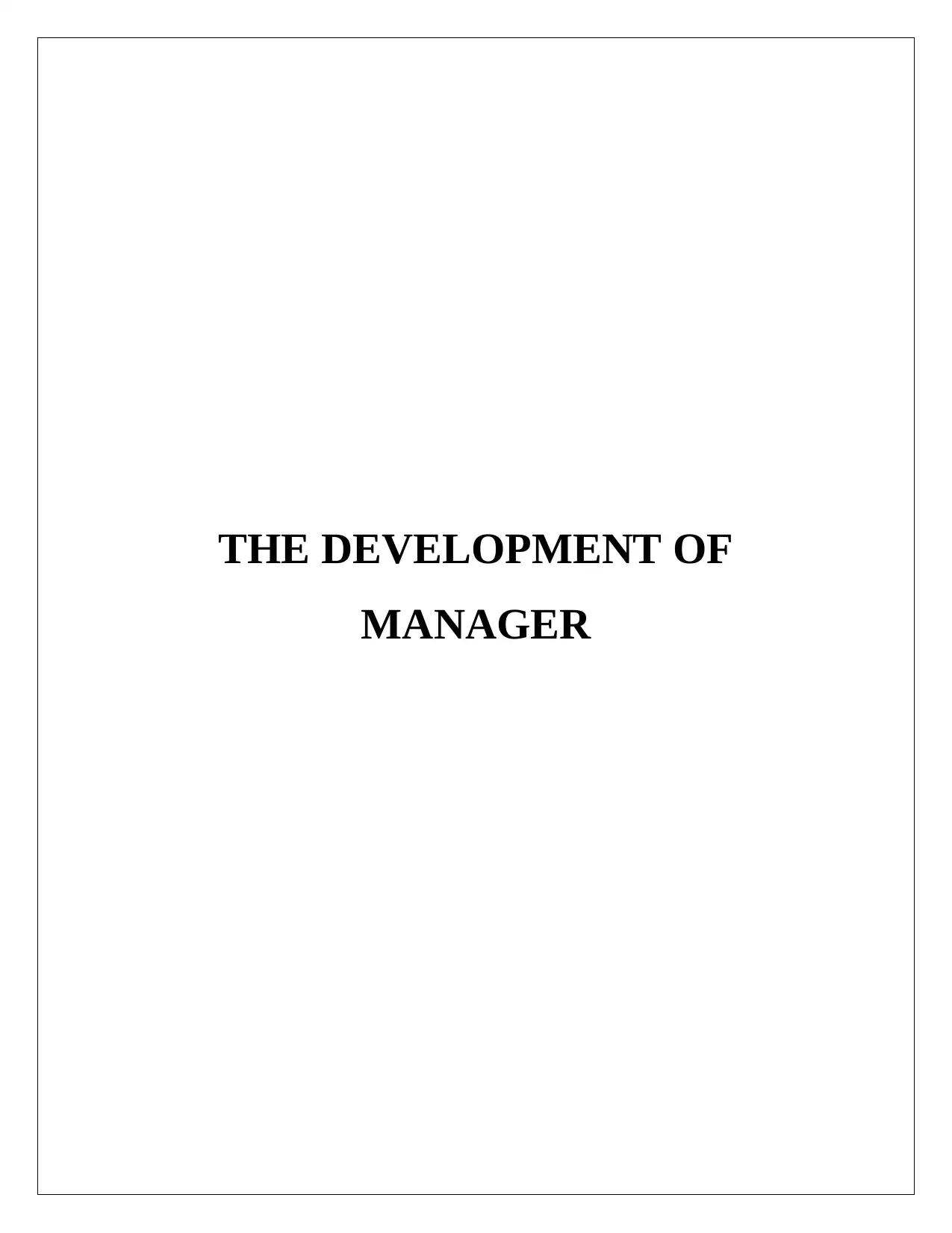
THE DEVELOPMENT OF
MANAGER
MANAGER
Paraphrase This Document
Need a fresh take? Get an instant paraphrase of this document with our AI Paraphraser
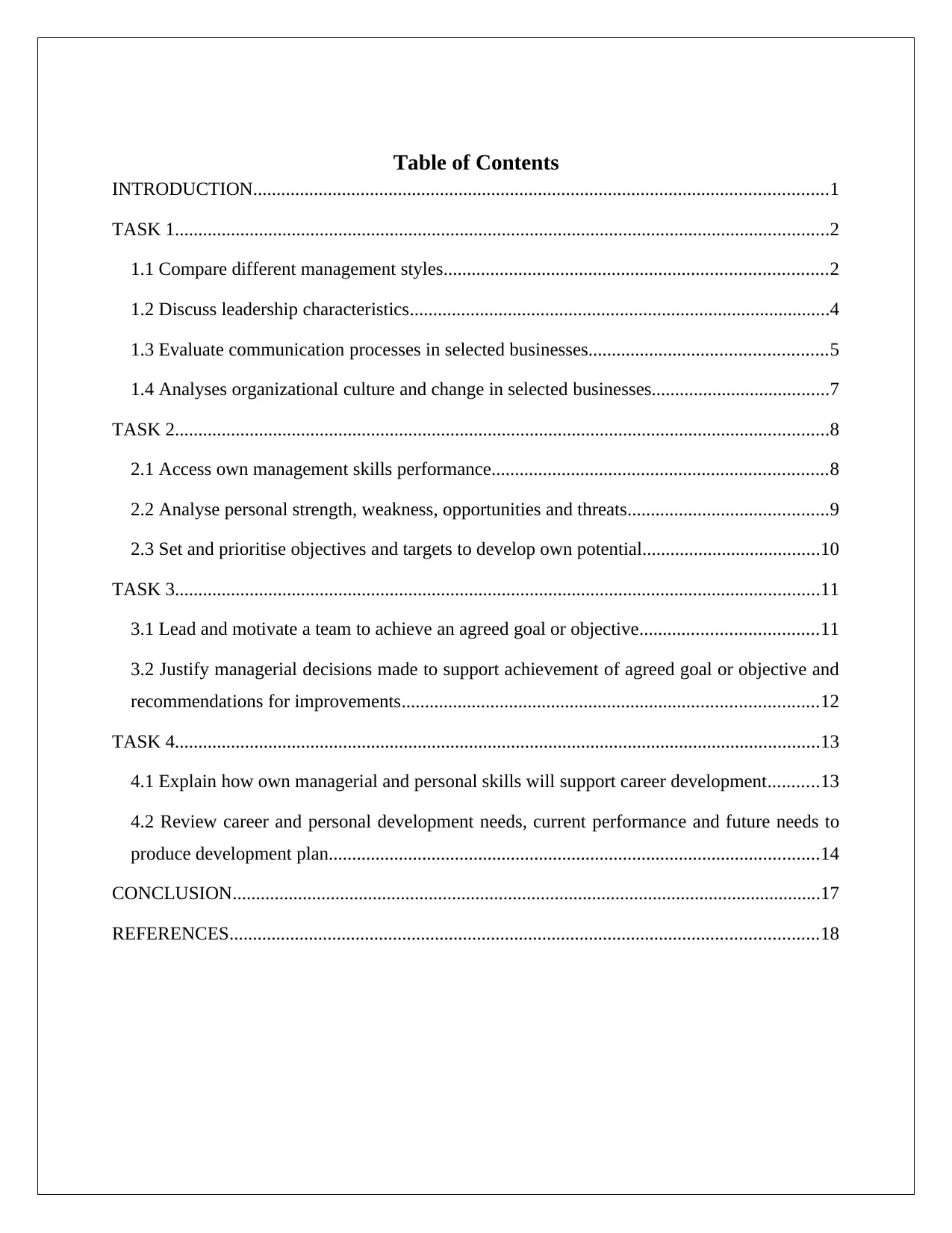
Table of Contents
INTRODUCTION...........................................................................................................................1
TASK 1............................................................................................................................................2
1.1 Compare different management styles..................................................................................2
1.2 Discuss leadership characteristics..........................................................................................4
1.3 Evaluate communication processes in selected businesses...................................................5
1.4 Analyses organizational culture and change in selected businesses......................................7
TASK 2............................................................................................................................................8
2.1 Access own management skills performance........................................................................8
2.2 Analyse personal strength, weakness, opportunities and threats...........................................9
2.3 Set and prioritise objectives and targets to develop own potential......................................10
TASK 3..........................................................................................................................................11
3.1 Lead and motivate a team to achieve an agreed goal or objective......................................11
3.2 Justify managerial decisions made to support achievement of agreed goal or objective and
recommendations for improvements.........................................................................................12
TASK 4..........................................................................................................................................13
4.1 Explain how own managerial and personal skills will support career development...........13
4.2 Review career and personal development needs, current performance and future needs to
produce development plan.........................................................................................................14
CONCLUSION..............................................................................................................................17
REFERENCES..............................................................................................................................18
INTRODUCTION...........................................................................................................................1
TASK 1............................................................................................................................................2
1.1 Compare different management styles..................................................................................2
1.2 Discuss leadership characteristics..........................................................................................4
1.3 Evaluate communication processes in selected businesses...................................................5
1.4 Analyses organizational culture and change in selected businesses......................................7
TASK 2............................................................................................................................................8
2.1 Access own management skills performance........................................................................8
2.2 Analyse personal strength, weakness, opportunities and threats...........................................9
2.3 Set and prioritise objectives and targets to develop own potential......................................10
TASK 3..........................................................................................................................................11
3.1 Lead and motivate a team to achieve an agreed goal or objective......................................11
3.2 Justify managerial decisions made to support achievement of agreed goal or objective and
recommendations for improvements.........................................................................................12
TASK 4..........................................................................................................................................13
4.1 Explain how own managerial and personal skills will support career development...........13
4.2 Review career and personal development needs, current performance and future needs to
produce development plan.........................................................................................................14
CONCLUSION..............................................................................................................................17
REFERENCES..............................................................................................................................18
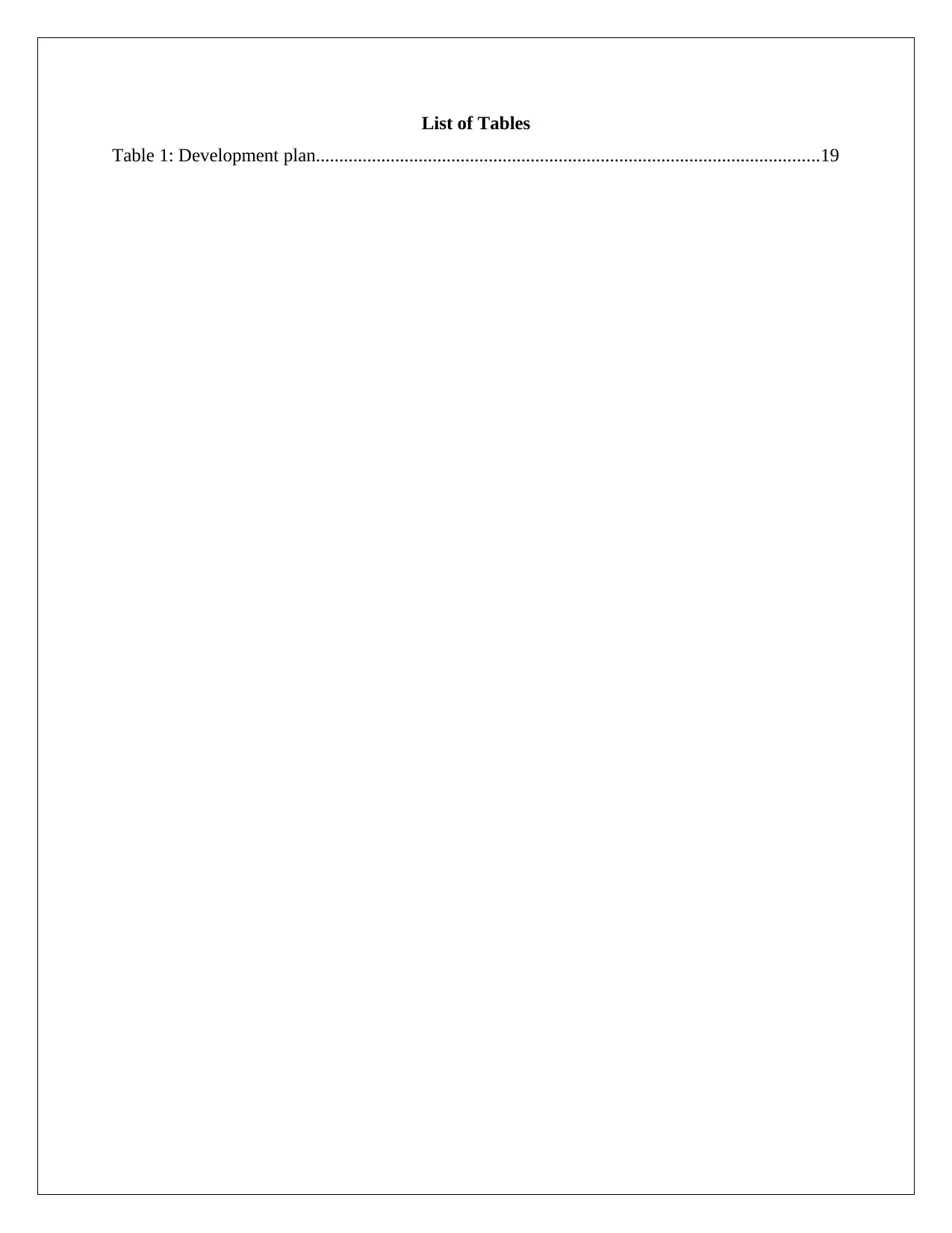
List of Tables
Table 1: Development plan............................................................................................................19
Table 1: Development plan............................................................................................................19
⊘ This is a preview!⊘
Do you want full access?
Subscribe today to unlock all pages.

Trusted by 1+ million students worldwide
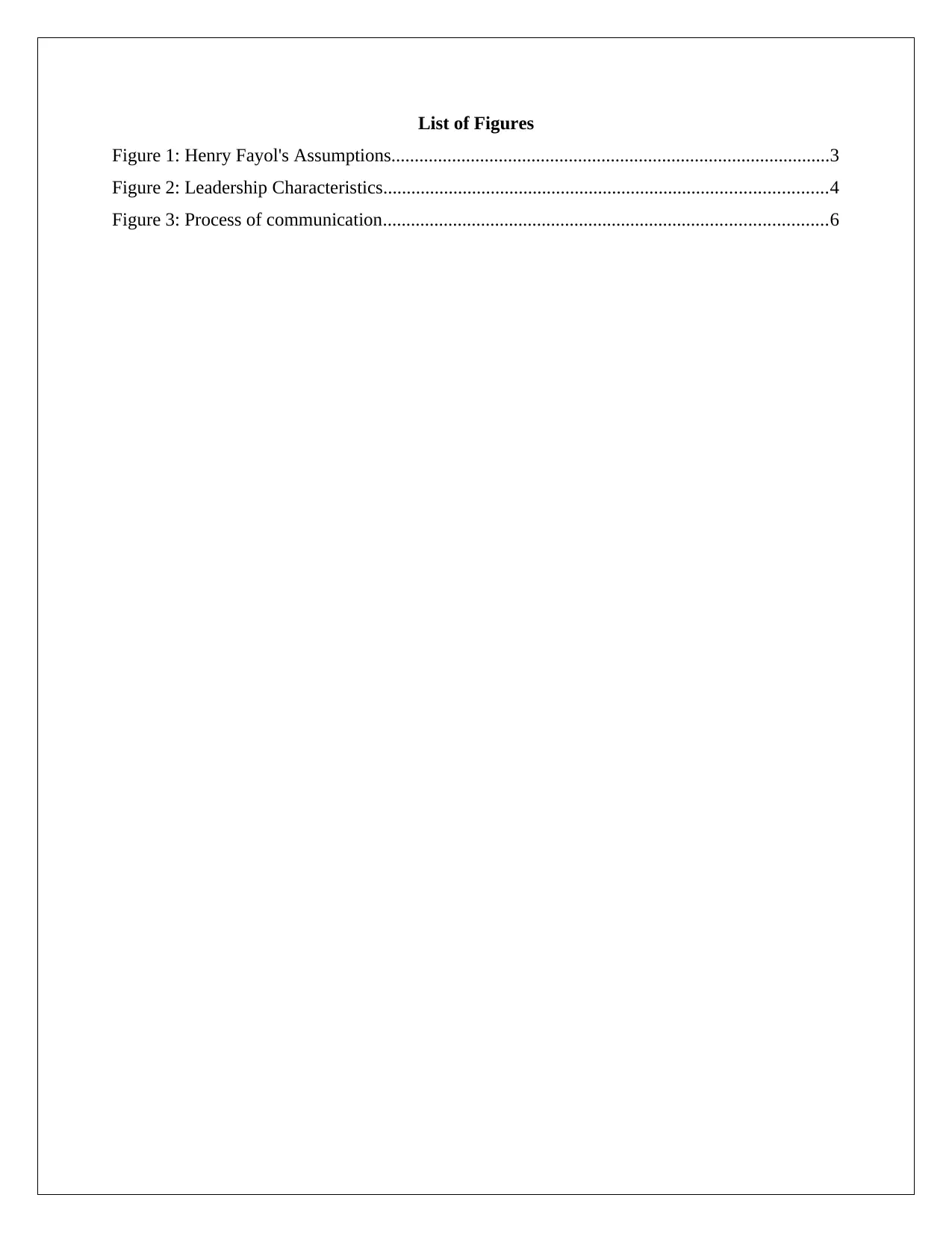
List of Figures
Figure 1: Henry Fayol's Assumptions..............................................................................................3
Figure 2: Leadership Characteristics...............................................................................................4
Figure 3: Process of communication...............................................................................................6
Figure 1: Henry Fayol's Assumptions..............................................................................................3
Figure 2: Leadership Characteristics...............................................................................................4
Figure 3: Process of communication...............................................................................................6
Paraphrase This Document
Need a fresh take? Get an instant paraphrase of this document with our AI Paraphraser
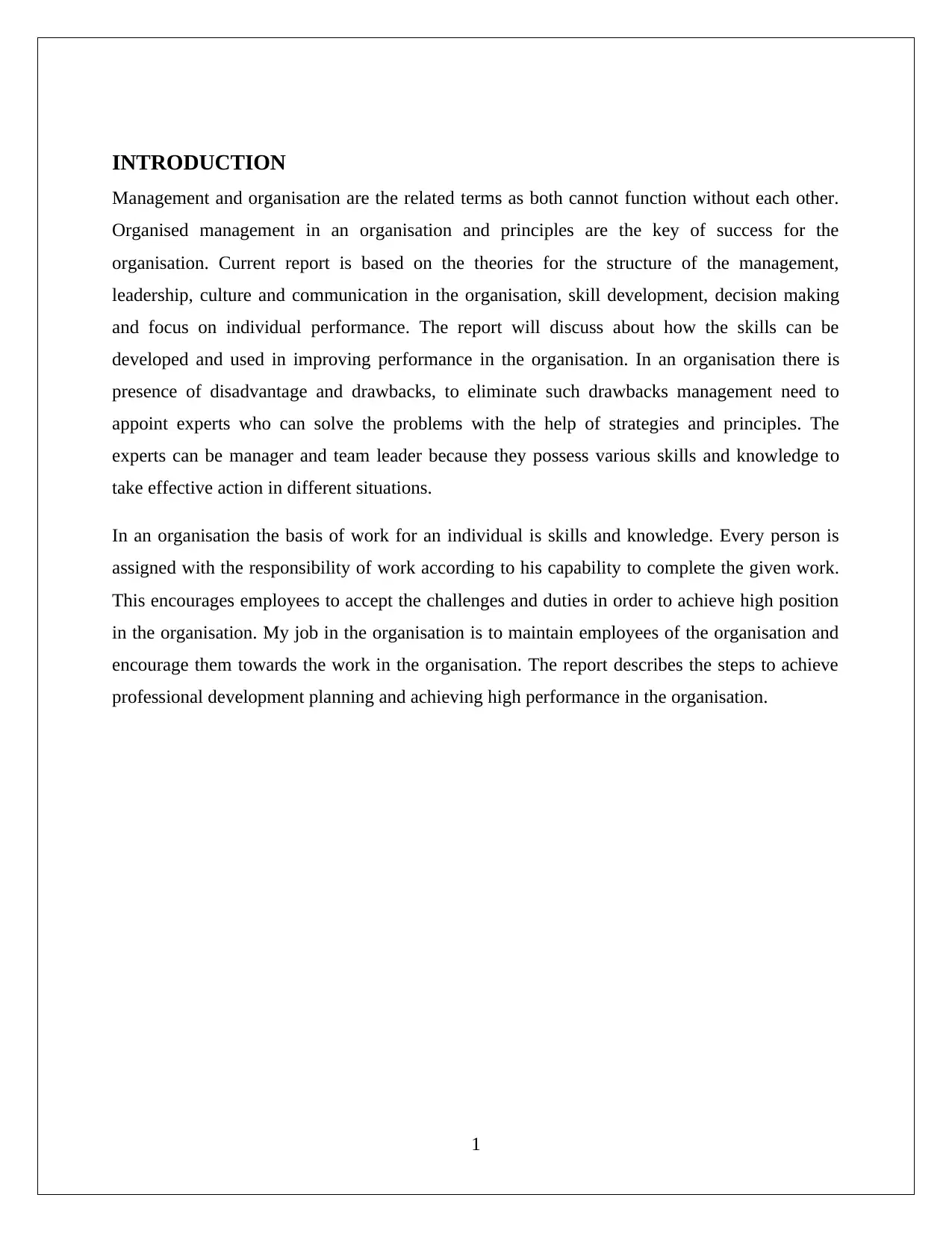
INTRODUCTION
Management and organisation are the related terms as both cannot function without each other.
Organised management in an organisation and principles are the key of success for the
organisation. Current report is based on the theories for the structure of the management,
leadership, culture and communication in the organisation, skill development, decision making
and focus on individual performance. The report will discuss about how the skills can be
developed and used in improving performance in the organisation. In an organisation there is
presence of disadvantage and drawbacks, to eliminate such drawbacks management need to
appoint experts who can solve the problems with the help of strategies and principles. The
experts can be manager and team leader because they possess various skills and knowledge to
take effective action in different situations.
In an organisation the basis of work for an individual is skills and knowledge. Every person is
assigned with the responsibility of work according to his capability to complete the given work.
This encourages employees to accept the challenges and duties in order to achieve high position
in the organisation. My job in the organisation is to maintain employees of the organisation and
encourage them towards the work in the organisation. The report describes the steps to achieve
professional development planning and achieving high performance in the organisation.
1
Management and organisation are the related terms as both cannot function without each other.
Organised management in an organisation and principles are the key of success for the
organisation. Current report is based on the theories for the structure of the management,
leadership, culture and communication in the organisation, skill development, decision making
and focus on individual performance. The report will discuss about how the skills can be
developed and used in improving performance in the organisation. In an organisation there is
presence of disadvantage and drawbacks, to eliminate such drawbacks management need to
appoint experts who can solve the problems with the help of strategies and principles. The
experts can be manager and team leader because they possess various skills and knowledge to
take effective action in different situations.
In an organisation the basis of work for an individual is skills and knowledge. Every person is
assigned with the responsibility of work according to his capability to complete the given work.
This encourages employees to accept the challenges and duties in order to achieve high position
in the organisation. My job in the organisation is to maintain employees of the organisation and
encourage them towards the work in the organisation. The report describes the steps to achieve
professional development planning and achieving high performance in the organisation.
1
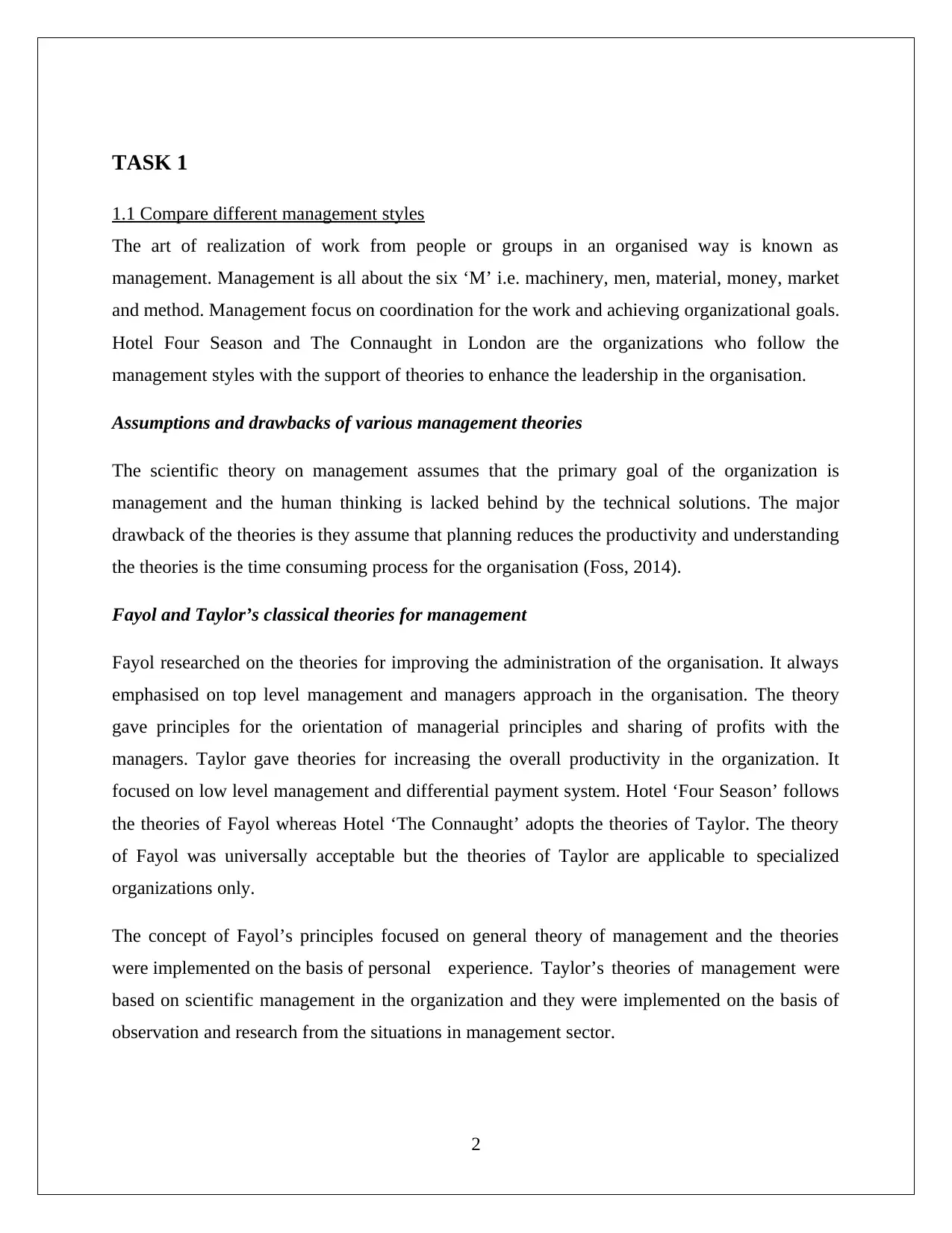
TASK 1
1.1 Compare different management styles
The art of realization of work from people or groups in an organised way is known as
management. Management is all about the six ‘M’ i.e. machinery, men, material, money, market
and method. Management focus on coordination for the work and achieving organizational goals.
Hotel Four Season and The Connaught in London are the organizations who follow the
management styles with the support of theories to enhance the leadership in the organisation.
Assumptions and drawbacks of various management theories
The scientific theory on management assumes that the primary goal of the organization is
management and the human thinking is lacked behind by the technical solutions. The major
drawback of the theories is they assume that planning reduces the productivity and understanding
the theories is the time consuming process for the organisation (Foss, 2014).
Fayol and Taylor’s classical theories for management
Fayol researched on the theories for improving the administration of the organisation. It always
emphasised on top level management and managers approach in the organisation. The theory
gave principles for the orientation of managerial principles and sharing of profits with the
managers. Taylor gave theories for increasing the overall productivity in the organization. It
focused on low level management and differential payment system. Hotel ‘Four Season’ follows
the theories of Fayol whereas Hotel ‘The Connaught’ adopts the theories of Taylor. The theory
of Fayol was universally acceptable but the theories of Taylor are applicable to specialized
organizations only.
The concept of Fayol’s principles focused on general theory of management and the theories
were implemented on the basis of personal experience. Taylor’s theories of management were
based on scientific management in the organization and they were implemented on the basis of
observation and research from the situations in management sector.
2
1.1 Compare different management styles
The art of realization of work from people or groups in an organised way is known as
management. Management is all about the six ‘M’ i.e. machinery, men, material, money, market
and method. Management focus on coordination for the work and achieving organizational goals.
Hotel Four Season and The Connaught in London are the organizations who follow the
management styles with the support of theories to enhance the leadership in the organisation.
Assumptions and drawbacks of various management theories
The scientific theory on management assumes that the primary goal of the organization is
management and the human thinking is lacked behind by the technical solutions. The major
drawback of the theories is they assume that planning reduces the productivity and understanding
the theories is the time consuming process for the organisation (Foss, 2014).
Fayol and Taylor’s classical theories for management
Fayol researched on the theories for improving the administration of the organisation. It always
emphasised on top level management and managers approach in the organisation. The theory
gave principles for the orientation of managerial principles and sharing of profits with the
managers. Taylor gave theories for increasing the overall productivity in the organization. It
focused on low level management and differential payment system. Hotel ‘Four Season’ follows
the theories of Fayol whereas Hotel ‘The Connaught’ adopts the theories of Taylor. The theory
of Fayol was universally acceptable but the theories of Taylor are applicable to specialized
organizations only.
The concept of Fayol’s principles focused on general theory of management and the theories
were implemented on the basis of personal experience. Taylor’s theories of management were
based on scientific management in the organization and they were implemented on the basis of
observation and research from the situations in management sector.
2
⊘ This is a preview!⊘
Do you want full access?
Subscribe today to unlock all pages.

Trusted by 1+ million students worldwide
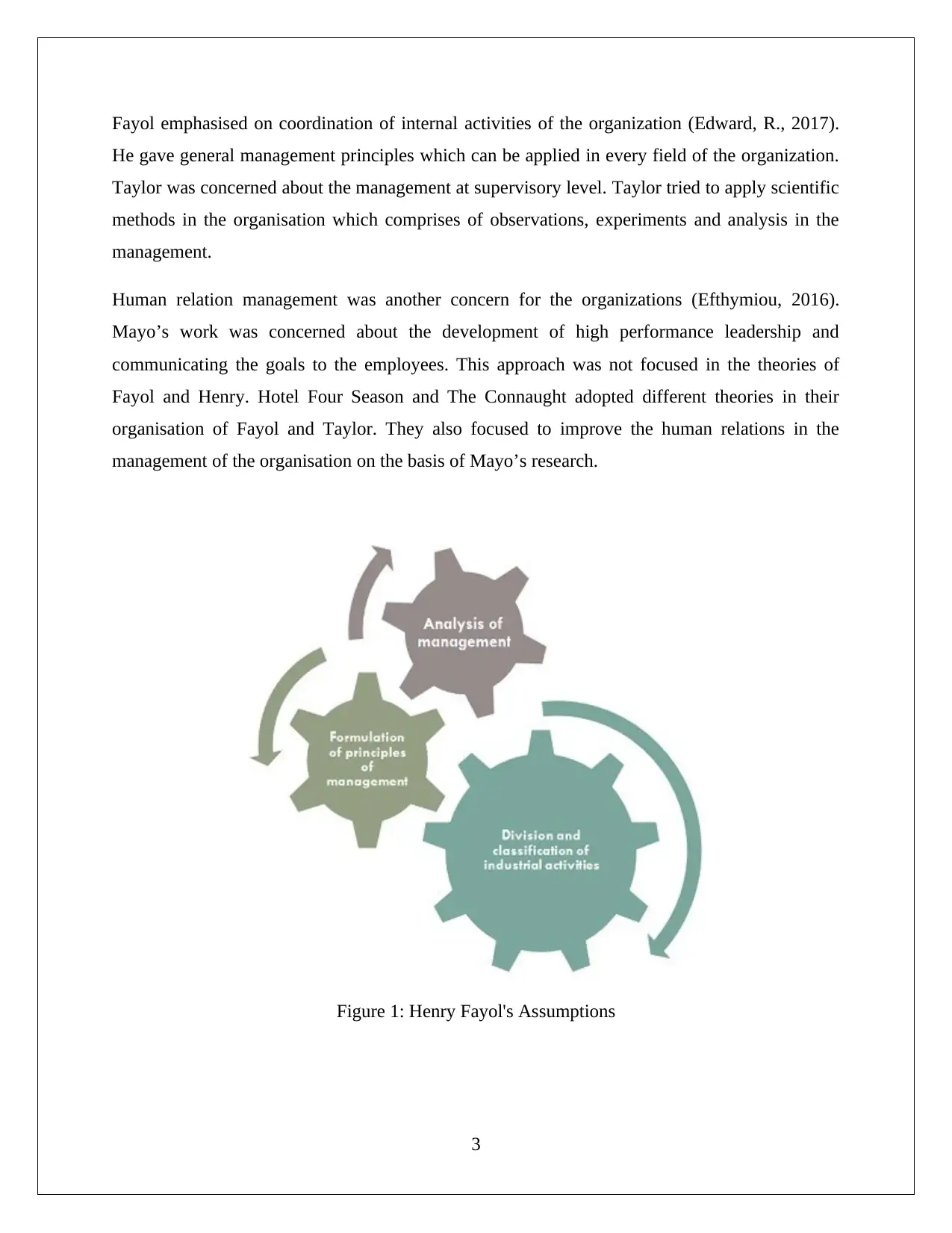
Fayol emphasised on coordination of internal activities of the organization (Edward, R., 2017).
He gave general management principles which can be applied in every field of the organization.
Taylor was concerned about the management at supervisory level. Taylor tried to apply scientific
methods in the organisation which comprises of observations, experiments and analysis in the
management.
Human relation management was another concern for the organizations (Efthymiou, 2016).
Mayo’s work was concerned about the development of high performance leadership and
communicating the goals to the employees. This approach was not focused in the theories of
Fayol and Henry. Hotel Four Season and The Connaught adopted different theories in their
organisation of Fayol and Taylor. They also focused to improve the human relations in the
management of the organisation on the basis of Mayo’s research.
Figure 1: Henry Fayol's Assumptions
3
He gave general management principles which can be applied in every field of the organization.
Taylor was concerned about the management at supervisory level. Taylor tried to apply scientific
methods in the organisation which comprises of observations, experiments and analysis in the
management.
Human relation management was another concern for the organizations (Efthymiou, 2016).
Mayo’s work was concerned about the development of high performance leadership and
communicating the goals to the employees. This approach was not focused in the theories of
Fayol and Henry. Hotel Four Season and The Connaught adopted different theories in their
organisation of Fayol and Taylor. They also focused to improve the human relations in the
management of the organisation on the basis of Mayo’s research.
Figure 1: Henry Fayol's Assumptions
3
Paraphrase This Document
Need a fresh take? Get an instant paraphrase of this document with our AI Paraphraser
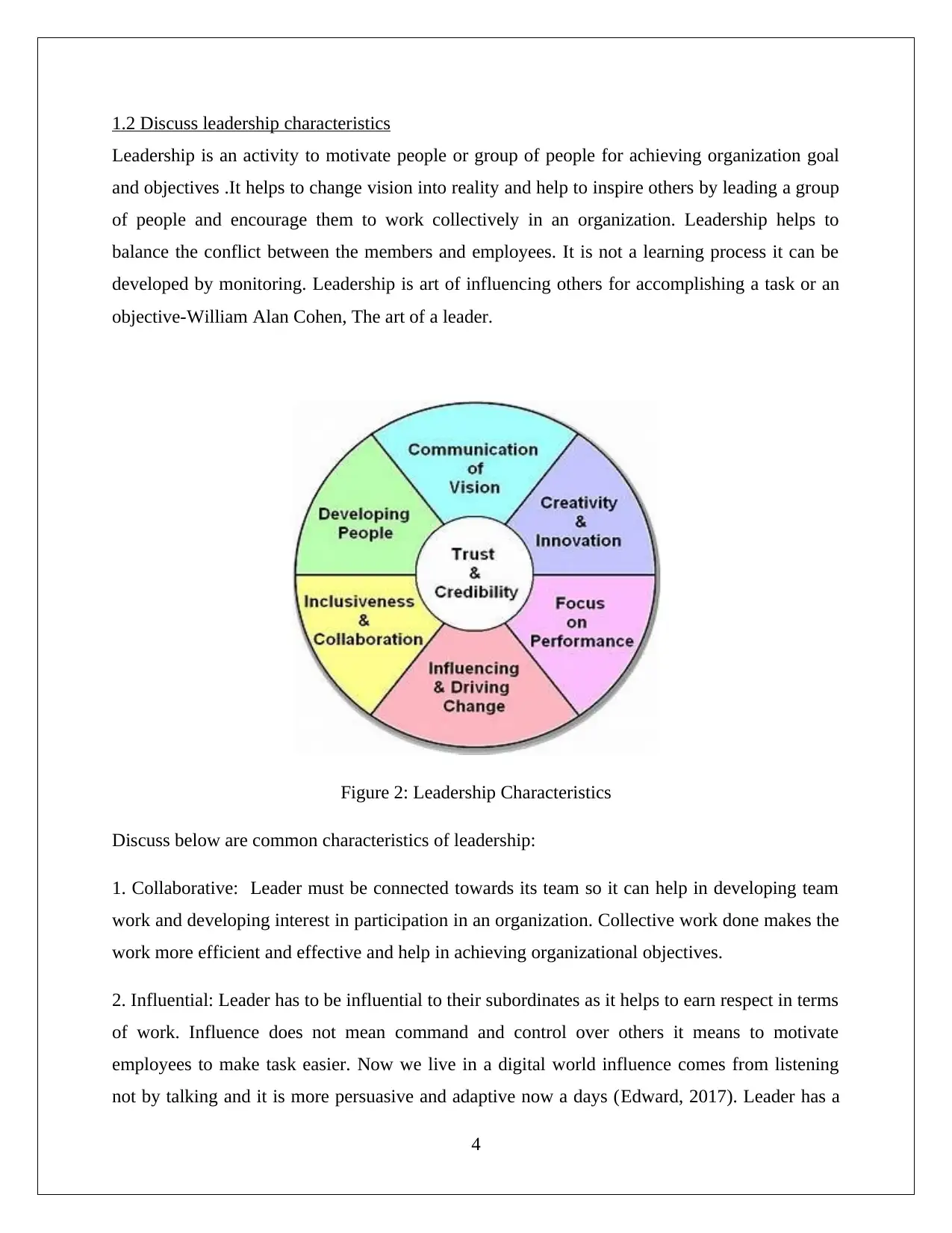
1.2 Discuss leadership characteristics
Leadership is an activity to motivate people or group of people for achieving organization goal
and objectives .It helps to change vision into reality and help to inspire others by leading a group
of people and encourage them to work collectively in an organization. Leadership helps to
balance the conflict between the members and employees. It is not a learning process it can be
developed by monitoring. Leadership is art of influencing others for accomplishing a task or an
objective-William Alan Cohen, The art of a leader.
Figure 2: Leadership Characteristics
Discuss below are common characteristics of leadership:
1. Collaborative: Leader must be connected towards its team so it can help in developing team
work and developing interest in participation in an organization. Collective work done makes the
work more efficient and effective and help in achieving organizational objectives.
2. Influential: Leader has to be influential to their subordinates as it helps to earn respect in terms
of work. Influence does not mean command and control over others it means to motivate
employees to make task easier. Now we live in a digital world influence comes from listening
not by talking and it is more persuasive and adaptive now a days (Edward, 2017). Leader has a
4
Leadership is an activity to motivate people or group of people for achieving organization goal
and objectives .It helps to change vision into reality and help to inspire others by leading a group
of people and encourage them to work collectively in an organization. Leadership helps to
balance the conflict between the members and employees. It is not a learning process it can be
developed by monitoring. Leadership is art of influencing others for accomplishing a task or an
objective-William Alan Cohen, The art of a leader.
Figure 2: Leadership Characteristics
Discuss below are common characteristics of leadership:
1. Collaborative: Leader must be connected towards its team so it can help in developing team
work and developing interest in participation in an organization. Collective work done makes the
work more efficient and effective and help in achieving organizational objectives.
2. Influential: Leader has to be influential to their subordinates as it helps to earn respect in terms
of work. Influence does not mean command and control over others it means to motivate
employees to make task easier. Now we live in a digital world influence comes from listening
not by talking and it is more persuasive and adaptive now a days (Edward, 2017). Leader has a
4
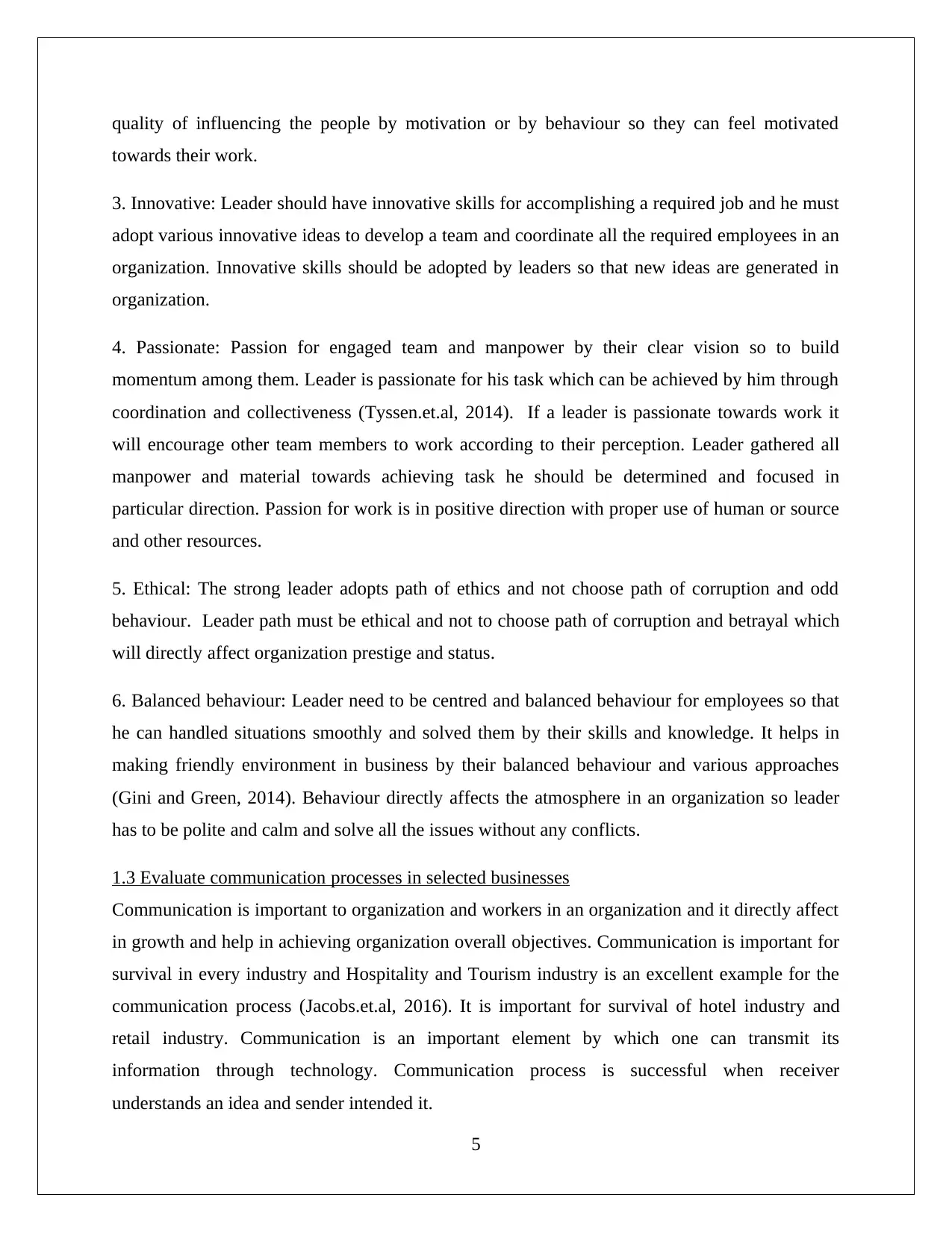
quality of influencing the people by motivation or by behaviour so they can feel motivated
towards their work.
3. Innovative: Leader should have innovative skills for accomplishing a required job and he must
adopt various innovative ideas to develop a team and coordinate all the required employees in an
organization. Innovative skills should be adopted by leaders so that new ideas are generated in
organization.
4. Passionate: Passion for engaged team and manpower by their clear vision so to build
momentum among them. Leader is passionate for his task which can be achieved by him through
coordination and collectiveness (Tyssen.et.al, 2014). If a leader is passionate towards work it
will encourage other team members to work according to their perception. Leader gathered all
manpower and material towards achieving task he should be determined and focused in
particular direction. Passion for work is in positive direction with proper use of human or source
and other resources.
5. Ethical: The strong leader adopts path of ethics and not choose path of corruption and odd
behaviour. Leader path must be ethical and not to choose path of corruption and betrayal which
will directly affect organization prestige and status.
6. Balanced behaviour: Leader need to be centred and balanced behaviour for employees so that
he can handled situations smoothly and solved them by their skills and knowledge. It helps in
making friendly environment in business by their balanced behaviour and various approaches
(Gini and Green, 2014). Behaviour directly affects the atmosphere in an organization so leader
has to be polite and calm and solve all the issues without any conflicts.
1.3 Evaluate communication processes in selected businesses
Communication is important to organization and workers in an organization and it directly affect
in growth and help in achieving organization overall objectives. Communication is important for
survival in every industry and Hospitality and Tourism industry is an excellent example for the
communication process (Jacobs.et.al, 2016). It is important for survival of hotel industry and
retail industry. Communication is an important element by which one can transmit its
information through technology. Communication process is successful when receiver
understands an idea and sender intended it.
5
towards their work.
3. Innovative: Leader should have innovative skills for accomplishing a required job and he must
adopt various innovative ideas to develop a team and coordinate all the required employees in an
organization. Innovative skills should be adopted by leaders so that new ideas are generated in
organization.
4. Passionate: Passion for engaged team and manpower by their clear vision so to build
momentum among them. Leader is passionate for his task which can be achieved by him through
coordination and collectiveness (Tyssen.et.al, 2014). If a leader is passionate towards work it
will encourage other team members to work according to their perception. Leader gathered all
manpower and material towards achieving task he should be determined and focused in
particular direction. Passion for work is in positive direction with proper use of human or source
and other resources.
5. Ethical: The strong leader adopts path of ethics and not choose path of corruption and odd
behaviour. Leader path must be ethical and not to choose path of corruption and betrayal which
will directly affect organization prestige and status.
6. Balanced behaviour: Leader need to be centred and balanced behaviour for employees so that
he can handled situations smoothly and solved them by their skills and knowledge. It helps in
making friendly environment in business by their balanced behaviour and various approaches
(Gini and Green, 2014). Behaviour directly affects the atmosphere in an organization so leader
has to be polite and calm and solve all the issues without any conflicts.
1.3 Evaluate communication processes in selected businesses
Communication is important to organization and workers in an organization and it directly affect
in growth and help in achieving organization overall objectives. Communication is important for
survival in every industry and Hospitality and Tourism industry is an excellent example for the
communication process (Jacobs.et.al, 2016). It is important for survival of hotel industry and
retail industry. Communication is an important element by which one can transmit its
information through technology. Communication process is successful when receiver
understands an idea and sender intended it.
5
⊘ This is a preview!⊘
Do you want full access?
Subscribe today to unlock all pages.

Trusted by 1+ million students worldwide
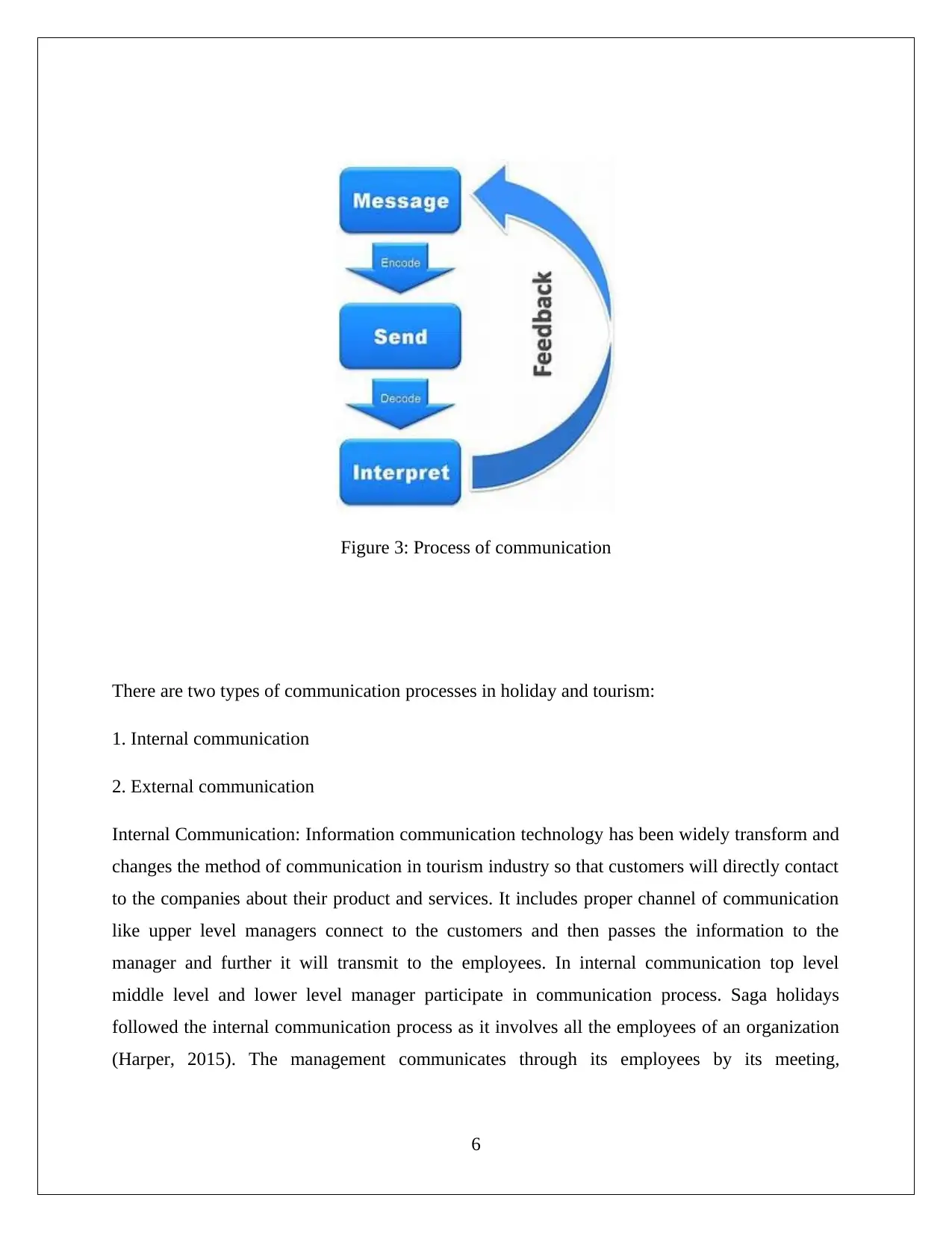
Figure 3: Process of communication
There are two types of communication processes in holiday and tourism:
1. Internal communication
2. External communication
Internal Communication: Information communication technology has been widely transform and
changes the method of communication in tourism industry so that customers will directly contact
to the companies about their product and services. It includes proper channel of communication
like upper level managers connect to the customers and then passes the information to the
manager and further it will transmit to the employees. In internal communication top level
middle level and lower level manager participate in communication process. Saga holidays
followed the internal communication process as it involves all the employees of an organization
(Harper, 2015). The management communicates through its employees by its meeting,
6
There are two types of communication processes in holiday and tourism:
1. Internal communication
2. External communication
Internal Communication: Information communication technology has been widely transform and
changes the method of communication in tourism industry so that customers will directly contact
to the companies about their product and services. It includes proper channel of communication
like upper level managers connect to the customers and then passes the information to the
manager and further it will transmit to the employees. In internal communication top level
middle level and lower level manager participate in communication process. Saga holidays
followed the internal communication process as it involves all the employees of an organization
(Harper, 2015). The management communicates through its employees by its meeting,
6
Paraphrase This Document
Need a fresh take? Get an instant paraphrase of this document with our AI Paraphraser
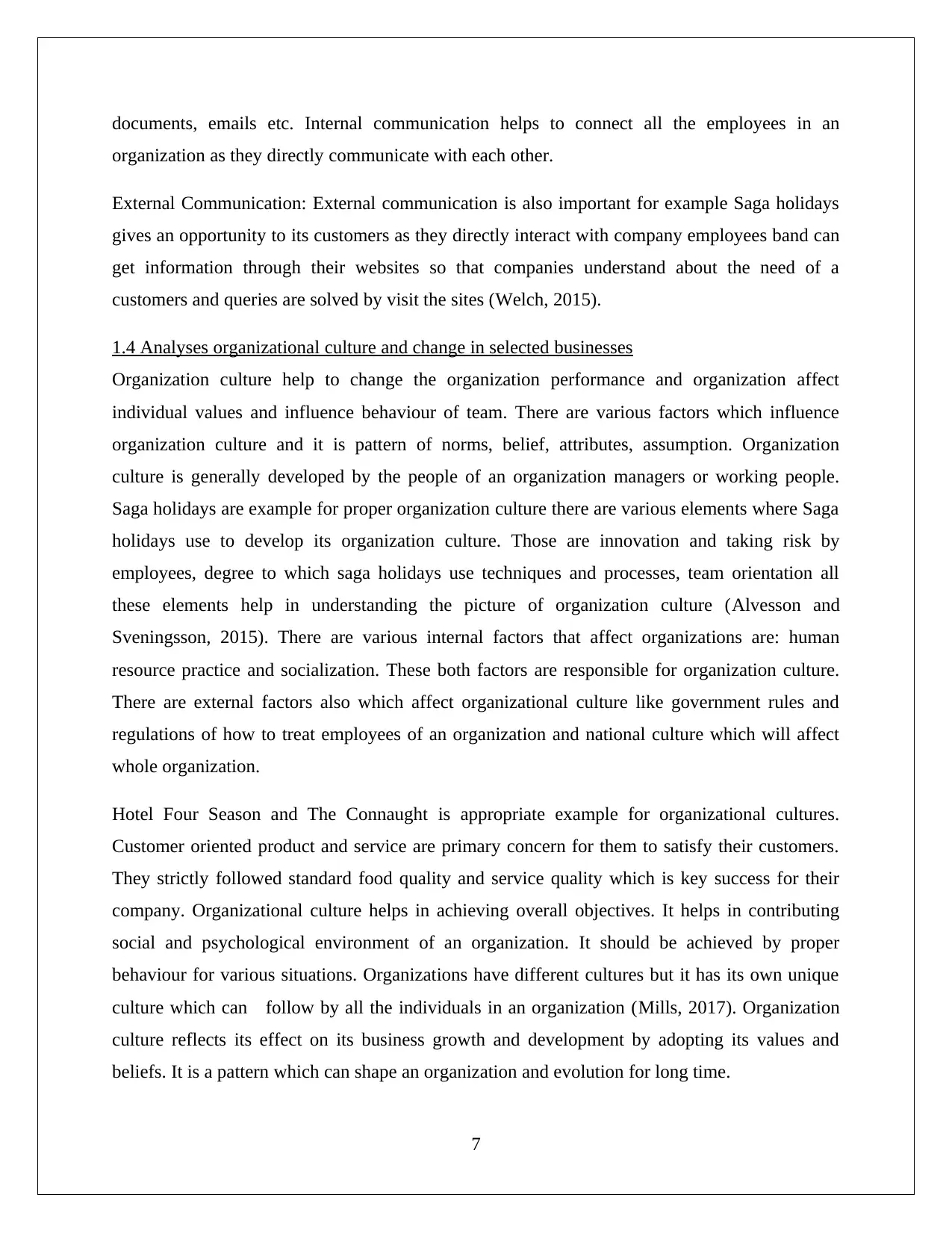
documents, emails etc. Internal communication helps to connect all the employees in an
organization as they directly communicate with each other.
External Communication: External communication is also important for example Saga holidays
gives an opportunity to its customers as they directly interact with company employees band can
get information through their websites so that companies understand about the need of a
customers and queries are solved by visit the sites (Welch, 2015).
1.4 Analyses organizational culture and change in selected businesses
Organization culture help to change the organization performance and organization affect
individual values and influence behaviour of team. There are various factors which influence
organization culture and it is pattern of norms, belief, attributes, assumption. Organization
culture is generally developed by the people of an organization managers or working people.
Saga holidays are example for proper organization culture there are various elements where Saga
holidays use to develop its organization culture. Those are innovation and taking risk by
employees, degree to which saga holidays use techniques and processes, team orientation all
these elements help in understanding the picture of organization culture (Alvesson and
Sveningsson, 2015). There are various internal factors that affect organizations are: human
resource practice and socialization. These both factors are responsible for organization culture.
There are external factors also which affect organizational culture like government rules and
regulations of how to treat employees of an organization and national culture which will affect
whole organization.
Hotel Four Season and The Connaught is appropriate example for organizational cultures.
Customer oriented product and service are primary concern for them to satisfy their customers.
They strictly followed standard food quality and service quality which is key success for their
company. Organizational culture helps in achieving overall objectives. It helps in contributing
social and psychological environment of an organization. It should be achieved by proper
behaviour for various situations. Organizations have different cultures but it has its own unique
culture which can follow by all the individuals in an organization (Mills, 2017). Organization
culture reflects its effect on its business growth and development by adopting its values and
beliefs. It is a pattern which can shape an organization and evolution for long time.
7
organization as they directly communicate with each other.
External Communication: External communication is also important for example Saga holidays
gives an opportunity to its customers as they directly interact with company employees band can
get information through their websites so that companies understand about the need of a
customers and queries are solved by visit the sites (Welch, 2015).
1.4 Analyses organizational culture and change in selected businesses
Organization culture help to change the organization performance and organization affect
individual values and influence behaviour of team. There are various factors which influence
organization culture and it is pattern of norms, belief, attributes, assumption. Organization
culture is generally developed by the people of an organization managers or working people.
Saga holidays are example for proper organization culture there are various elements where Saga
holidays use to develop its organization culture. Those are innovation and taking risk by
employees, degree to which saga holidays use techniques and processes, team orientation all
these elements help in understanding the picture of organization culture (Alvesson and
Sveningsson, 2015). There are various internal factors that affect organizations are: human
resource practice and socialization. These both factors are responsible for organization culture.
There are external factors also which affect organizational culture like government rules and
regulations of how to treat employees of an organization and national culture which will affect
whole organization.
Hotel Four Season and The Connaught is appropriate example for organizational cultures.
Customer oriented product and service are primary concern for them to satisfy their customers.
They strictly followed standard food quality and service quality which is key success for their
company. Organizational culture helps in achieving overall objectives. It helps in contributing
social and psychological environment of an organization. It should be achieved by proper
behaviour for various situations. Organizations have different cultures but it has its own unique
culture which can follow by all the individuals in an organization (Mills, 2017). Organization
culture reflects its effect on its business growth and development by adopting its values and
beliefs. It is a pattern which can shape an organization and evolution for long time.
7
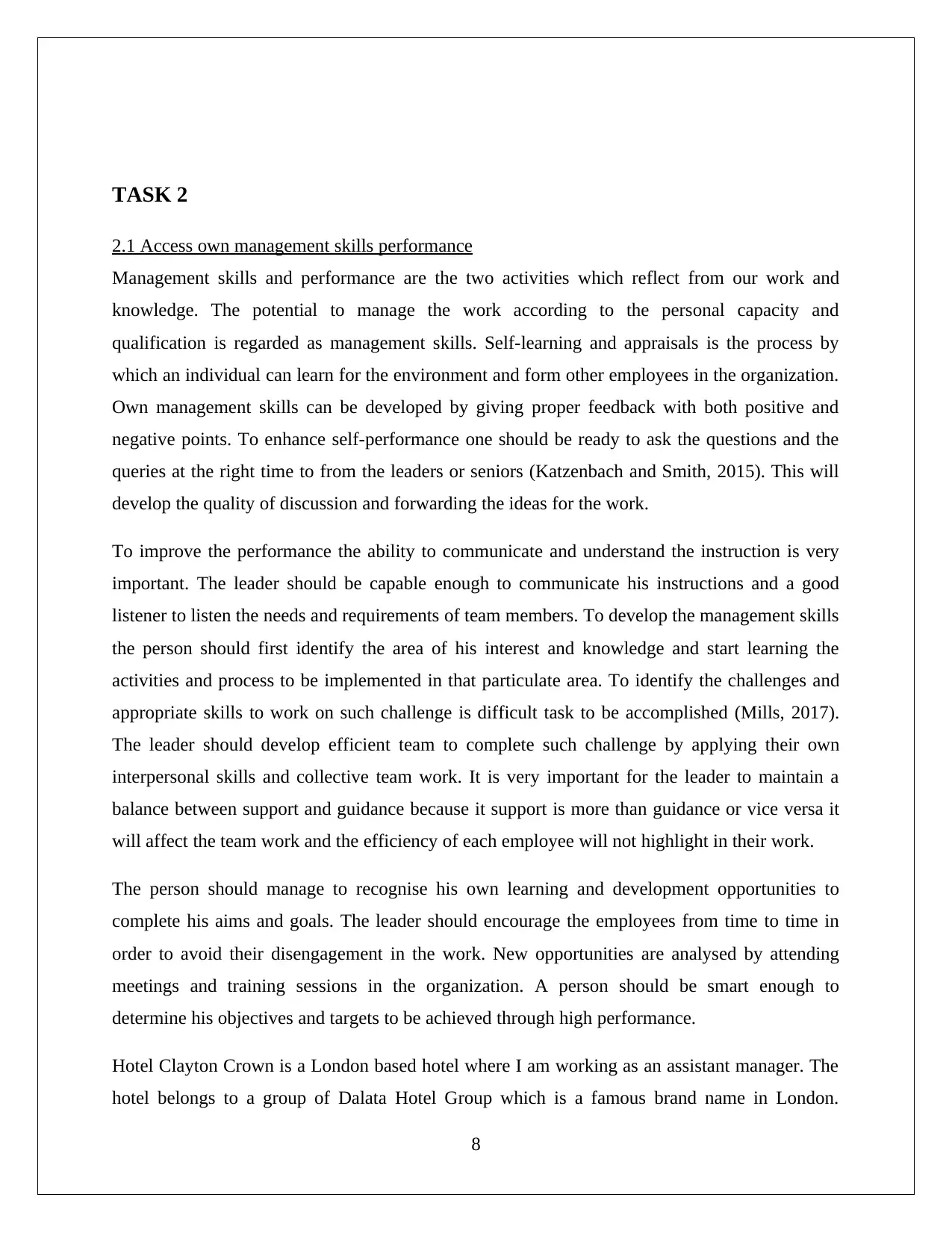
TASK 2
2.1 Access own management skills performance
Management skills and performance are the two activities which reflect from our work and
knowledge. The potential to manage the work according to the personal capacity and
qualification is regarded as management skills. Self-learning and appraisals is the process by
which an individual can learn for the environment and form other employees in the organization.
Own management skills can be developed by giving proper feedback with both positive and
negative points. To enhance self-performance one should be ready to ask the questions and the
queries at the right time to from the leaders or seniors (Katzenbach and Smith, 2015). This will
develop the quality of discussion and forwarding the ideas for the work.
To improve the performance the ability to communicate and understand the instruction is very
important. The leader should be capable enough to communicate his instructions and a good
listener to listen the needs and requirements of team members. To develop the management skills
the person should first identify the area of his interest and knowledge and start learning the
activities and process to be implemented in that particulate area. To identify the challenges and
appropriate skills to work on such challenge is difficult task to be accomplished (Mills, 2017).
The leader should develop efficient team to complete such challenge by applying their own
interpersonal skills and collective team work. It is very important for the leader to maintain a
balance between support and guidance because it support is more than guidance or vice versa it
will affect the team work and the efficiency of each employee will not highlight in their work.
The person should manage to recognise his own learning and development opportunities to
complete his aims and goals. The leader should encourage the employees from time to time in
order to avoid their disengagement in the work. New opportunities are analysed by attending
meetings and training sessions in the organization. A person should be smart enough to
determine his objectives and targets to be achieved through high performance.
Hotel Clayton Crown is a London based hotel where I am working as an assistant manager. The
hotel belongs to a group of Dalata Hotel Group which is a famous brand name in London.
8
2.1 Access own management skills performance
Management skills and performance are the two activities which reflect from our work and
knowledge. The potential to manage the work according to the personal capacity and
qualification is regarded as management skills. Self-learning and appraisals is the process by
which an individual can learn for the environment and form other employees in the organization.
Own management skills can be developed by giving proper feedback with both positive and
negative points. To enhance self-performance one should be ready to ask the questions and the
queries at the right time to from the leaders or seniors (Katzenbach and Smith, 2015). This will
develop the quality of discussion and forwarding the ideas for the work.
To improve the performance the ability to communicate and understand the instruction is very
important. The leader should be capable enough to communicate his instructions and a good
listener to listen the needs and requirements of team members. To develop the management skills
the person should first identify the area of his interest and knowledge and start learning the
activities and process to be implemented in that particulate area. To identify the challenges and
appropriate skills to work on such challenge is difficult task to be accomplished (Mills, 2017).
The leader should develop efficient team to complete such challenge by applying their own
interpersonal skills and collective team work. It is very important for the leader to maintain a
balance between support and guidance because it support is more than guidance or vice versa it
will affect the team work and the efficiency of each employee will not highlight in their work.
The person should manage to recognise his own learning and development opportunities to
complete his aims and goals. The leader should encourage the employees from time to time in
order to avoid their disengagement in the work. New opportunities are analysed by attending
meetings and training sessions in the organization. A person should be smart enough to
determine his objectives and targets to be achieved through high performance.
Hotel Clayton Crown is a London based hotel where I am working as an assistant manager. The
hotel belongs to a group of Dalata Hotel Group which is a famous brand name in London.
8
⊘ This is a preview!⊘
Do you want full access?
Subscribe today to unlock all pages.

Trusted by 1+ million students worldwide
1 out of 24
Related Documents
Your All-in-One AI-Powered Toolkit for Academic Success.
+13062052269
info@desklib.com
Available 24*7 on WhatsApp / Email
![[object Object]](/_next/static/media/star-bottom.7253800d.svg)
Unlock your academic potential
Copyright © 2020–2025 A2Z Services. All Rights Reserved. Developed and managed by ZUCOL.




